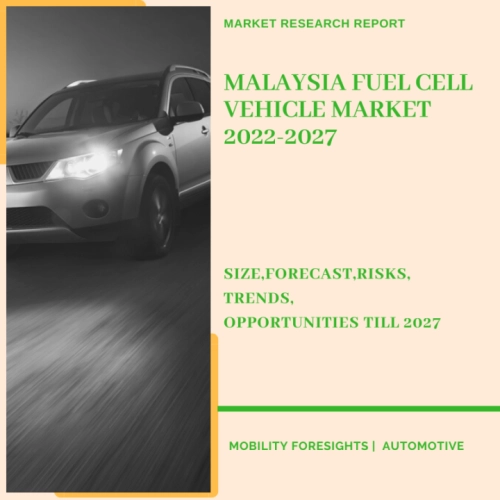
- Get in Touch with Us

Last Updated: Apr 25, 2025 | Study Period: 2022-2027
A fuel cell vehicle (FCV) or fuel cell electric vehicle (FCEV) is an electric vehicle that uses a fuel cell to power its onboard electric motor, sometimes in conjunction with a tiny battery or supercapacitor.
In order to generate electricity, fuel cells in cars typically use compressed hydrogen and oxygen from the air.
The majority of fuel cell vehicles are categorised as zero-emission vehicles because they only produce heat and water.
In comparison to internal combustion vehicles, hydrogen-powered vehicles concentrate pollution at the location of hydrogen production, where hydrogen is normally made from natural gas that has undergone reformation.

The Malaysia Fuel Cell Vehicle Market accounted for $XX Billion in 2021 and is anticipated to reach $XX Billion by 2026, registering a CAGR of XX% from 2022 to 2027.
For usage on campuses, researchers at Universiti Kebangsaan Malaysia (UKM) have created hydrogen hybrid vehicles that utilise hydrogen fuel cells.
Hydrogen and oxygen are combined in the hydrogen fuel cells to create electrical energy and safe water vapour as a byproduct.
The cars are referred to as the UKM-FCH2HC, a miniature hybrid SUV, and the UKM-FCH2B, a buggy. By modifying electric vehicles, the hydrogen fuel cell vehicles were created in cooperation with industry partners (EVs).
H2X has started making hydrogen fuel cell vehicles in Sarawak, Malaysia. The MOU for an incorporated joint venture between Sarawak Economic Development Corporation (SEDC) and H2X Global for the manufacturing, assembly, and development of a variety of strategic transport projects was signed by SEDC Energy, a wholly owned subsidiary of SEDC.
The joint venture is a long-term commitment to develop vehicle and component production over time and to start assembling relevant vehicles right away, such as the Warrego Pickup, City Buses, and H2x Hydrogen Powered Generators, while utilising the hydrogen distribution network set up within Sarawak State Malaysia.
| Sl no | Topic |
| 1 | Market Segmentation |
| 2 | Scope of the report |
| 3 | Abbreviations |
| 4 | Research Methodology |
| 5 | Executive Summary |
| 6 | Introduction |
| 7 | Insights from Industry stakeholders |
| 8 | Cost breakdown of Product by sub-components and average profit margin |
| 9 | Disruptive innovation in the Industry |
| 10 | Technology trends in the Industry |
| 11 | Consumer trends in the industry |
| 12 | Recent Production Milestones |
| 13 | Component Manufacturing in US, EU and China |
| 14 | COVID-19 impact on overall market |
| 15 | COVID-19 impact on Production of components |
| 16 | COVID-19 impact on Point of sale |
| 17 | Market Segmentation, Dynamics and Forecast by Geography, 2022-2027 |
| 18 | Market Segmentation, Dynamics and Forecast by Product Type, 2022-2027 |
| 19 | Market Segmentation, Dynamics and Forecast by Application, 2022-2027 |
| 20 | Market Segmentation, Dynamics and Forecast by End use, 2022-2027 |
| 21 | Product installation rate by OEM, 2022 |
| 22 | Incline/Decline in Average B-2-B selling price in past 5 years |
| 23 | Competition from substitute products |
| 24 | Gross margin and average profitability of suppliers |
| 25 | New product development in past 12 months |
| 26 | M&A in past 12 months |
| 27 | Growth strategy of leading players |
| 28 | Market share of vendors, 2022 |
| 29 | Company Profiles |
| 30 | Unmet needs and opportunity for new suppliers |
| 31 | Conclusion |
| 32 | Appendix |